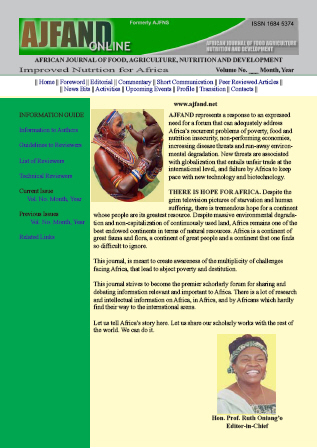
|
African Journal of Food, Agriculture, Nutrition and Development
Rural Outreach Program
ISSN: 1684-5358
EISSN: 1684-5358
Vol. 20, No. 3, 2020, pp. 15723-15740
|
 Bioline Code: nd20035
Bioline Code: nd20035
Full paper language: English
Document type: Research Article
Document available free of charge
|
|
|
African Journal of Food, Agriculture, Nutrition and Development, Vol. 20, No. 3, 2020, pp. 15723-15740
| en |
PROFITABILITY OF FERTILIZER USE IN PINEAPPLE PRODUCTION IN BENIN
Honfoga, BG; Padonou, EG; Padonou, PFG & Amadji, GL
Abstract
With a contribution of 4.3% to agricultural gross domestic product (GDP) behind cashew (7.4%) and cotton (25%), pineapple has become the third export crop in Benin. However, its yields are still below the potential. Sub-optimal potassium/nitrogen (K/N) ratio in fertilizer use is leading to low fruit quality and limited market outreach. Therefore, an experimental research project was implemented to determine an optimal fertilizer use practice. This paper compares the profitability of the best experimental fertilizer use practice with that of farmers’ practices using relevant indicators. Experimental and socioeconomic data were collected from 89 randomly selected pineapple growers among 5381 growers in Zè district. The findings revealed that fertilizer use had a positive marginal effect on pineapple production with both practices. Most importantly, the experimental practice was 2-3 times more profitable than farmers’ fertilizer use practice and could be recommended. The rate of pineapple’s response to fertilizer almost doubled from 13.42 kg fruit/kg fertilizer with farmers’ practices to 23.07 kg fruit/kg fertilizer with the experimental practice. While the profit rate of pineapple production was almost the same (86%) without fertilizer use in both practices, it rather increased more than 2-fold with the experimental practice, reaching 290% against 121% with farmers’ practices. Fertilizer use therefore enabled pineapple production profitability to increase from 39% with farmers’ practices to 238% with the experimental practice. This practice doubled the marginal effect of fertilizer use and doubled the classic value/cost ratio. However, farmers cannot yet harvest the promised gold as only 1% among them presently apply that high-dose best practice. Labour availability and costs for fractioning the optimum dose over the crop’s growing cycle remains a challenge. Further, pineapple’s high perishability is another challenge which calls for building strong value chains to enable growers readily direct their harvests to more rewarding markets. Further research is still needed to factor those constraints’ alleviation into determining the “real” or affordably relevant optimal doses of fertilizer on pineapple in poor farming settings as the Zè district of Benin. Growers’ perceptions on innovative practices and their own financing strategies will be critical to foster the adoption of improved fertilizer use technologies and boost agricultural productivity in Benin. In the meantime, access to credit and off-farm activities are likely to enable a larger adoption of the optimal dose.
Keywords
fertilizer use; pineapple production practices; adoption; marginal profit; value-cost ratio; poverty reduction
|
| |
© Copyright [2020] - African Journal of Food, Agriculture, Nutrition and Development
Alternative site location: http://www.ajfand.net/
|
|
